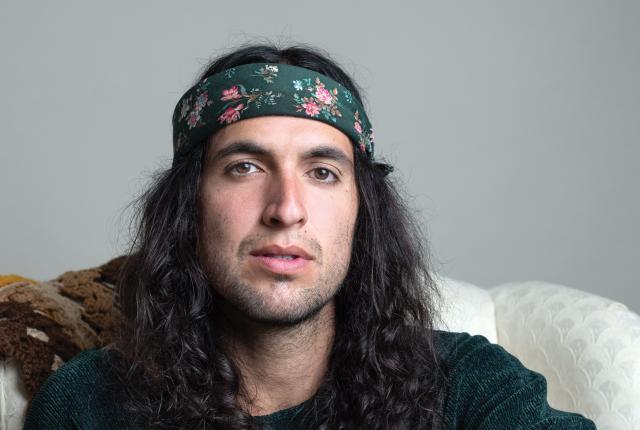Above: Diego Medina. Photograph by Brandon Soder.
ORIGINALLY FROM Las Cruces, Diego Medina lives and works in Santa Fe as an educational assistant at the Indian Arts Research Center, where he brings Native-centered curricula to incarcerated youths and local students. A visual artist, Medina culls from his own mixed Rarámuri/Genizarx/Irish heritage to draw detailed colored-pencil portraits of loved ones. Recently, he collaborated with indigenous-owned lingerie brand Shy Natives to create custom prints that debuted on tees and tote bags at the SWAIA Indian Market Haute Couture Fashion Show. On Instagram, followers can find his artwork, messages of affirmation, and self-portraits, in which he sometimes wears lacy camisoles, glitter, and a signature bandanna around his head. Regardless of medium, Medina is a champion of expression and a pillar of connection in his creative Native community.
Previously, I was a public school teacher. I taught middle school special ed in Phoenix. Right now, I do educational programming in Santa Fe that focuses on bringing Native voices into the classroom, and I do a lot of outreach with Native communities surrounding Santa Fe and throughout New Mexico.
I was born near Las Cruces. My family owns one of the oldest historic adobe homes in the Mesquite District there. It was built by my great-grandfather, who came from the Sierra Tarahumara, in Chihuahua, Mexico. When he was a teenager, he ran all the way to the Territory of New Mexico. To become a U.S. citizen, he joined Teddy Roosevelt’s Rough Riders and fought in Cuba in the Spanish American War, jumped off a train and hurt his foot, and got an honorary discharge. He came back and apprenticed with a painter in El Paso, painting a lot of signs in Las Cruces around the original Mesilla Plaza.
We know he descended from Native slaves who worked in the silver mines near Parral. Stories of the history of Native slavery within the whole Southwest and into Mexico are very potent and tied to the messages I want to get across in my writing and my art. Having that in my family heritage and having those family stories are part of that.
I’ve been drawing for as long as I can remember.
My grandma would babysit me when I was a kid. As a child, she cleaned houses for a living and worked at a grocery store, but never had the opportunity to be an artist. When I was growing up, I had a lot of creative forces running through me, and drawing helped me get those out. My grandma helped me understand that it was a good thing, and not in a didactic way, but by example she helped me channel that energy into drawing.
Five or six years ago I had a really bad nerve injury to my arm. I went to therapy, and when I was able to regain use after a year, I began drawing portraits. It started as a way to practice using my hand again, and then it became more of a medium to express all the things I was feeling. To me, making portraits of family is one of the best ways to see the beauty in myself.
There are so many ways that Native people get relegated into identity boxes, and so many times when Native identities get subsumed into one thing, like Native people are this or that. Being of indigenous descent means that you have an abundance of political rhetoric and stereotypes to contend with, along with your own individual experience. Both can define us as people and push us to grow. Am I different from the rest of my ancestors? Absolutely. Am I forever connected to them? Absolutely. To say someone isn’t “Native enough” based on arbitrary standards is to say that they aren’t a valid person, and that’s not okay. Everybody inherits identity differently.
No matter how connected to community you are, there are always times when you’re alone. That’s what I write for. That’s what I make art for. A community is only as strong as the people in it, and everybody has times where they are alone, lost. In my art, I want to be there with them by their side, be a little bit of love next to them.

SEE FOR YOURSELF
Medina’s first solo show at LOOM Indigenous Art Gallery, in Gallup, runs through December 13.


